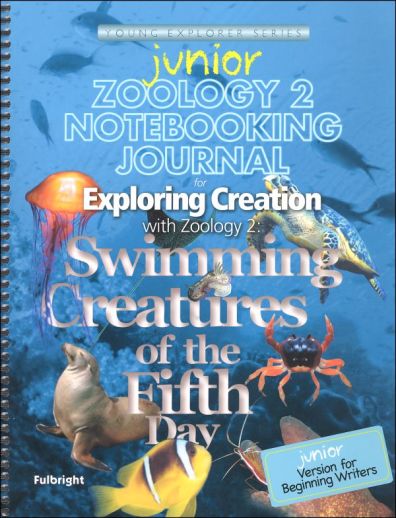We use cookies to make your experience better. To comply with the new e-Privacy directive, we need to ask for your consent to set the cookies. Learn more.
Zoology 2 Junior Notebooking Journal
Junior Notebooking Journals are a simplified version of the original Notebooking Journals and require less handwriting but have the same reinforcing activities. These books include coloring pages, project pages, and cut and fold miniature books (same ones as in the version for older students). There is space for notebooking assignments (more drawings, no questions to answer) and scripture copywork (shorter verses to copy either in manuscript or in beginning cursive). Biblical quotations are from the NASB, KJV, NIV or NKJV.
The Zoology 2 Junior Notebooking Journal is one of the newest in the product line of the Young Explorer Series. A companion to Exploring Creation with Zoology 2, this junior journal is much like the regular Zoology 2 Notebooking Journal but is designed for younger students or those with limited writing skills. All the lines in the junior journal are primary writing lines (a dashed line between two solid lines), and there are far fewer than in the regular journal. The Zoology 2 Junior Notebooking Journal is perfect for:
- Younger students that have not yet mastered handwriting
- Older students that are delayed in handwriting mastery
- Older students with learning disabilities
- Students that are new to written narration
Each lesson in the junior journal begins with two fun coloring pages for the student to color while he listens to the reading of the text. These pages provide opportunities for active learning while reinforcing the lesson's content. Following are pages with templates designed to encourage creative expression and written narration. The student can illustrate what he's learned and write a sentence or two about the topic. Next, the student is given the opportunity to work with and learn key vocabulary words presented in the text. Included are puzzle piece cut out and match vocabulary activities, partially filled in crosswords, vocabulary stories, animal identification activities and more. These learning activities are not only fun, but they increase the student's retention of both the important terms and the subject matter presented in the lessons. In addition to vocabulary work, the student has the opportunity to practice his handwriting and is given the choice between print copywork, cursive copywork or both. The Scriptures used for copywork are shorter than in the regular notebooking journal, and the font is larger. Templates to complete all the notebooking assignments, project record keeping, Scientific Speculation Sheets and, of course, the same beautiful, full-colored miniature books found in the original notebooking journal are included in the junior journal. There are some higher level activities missing from the junior journal, but they are replaced with cut and paste, high interest learning activities that bring the subject to life.
Apologia Science courses are written from a Biblical worldview with the homeschool in mind. At the elementary level, courses follow a Charlotte Mason-inspired methodology, with lessons organized around narration, notebooking exercises and hands-on activities or projects. Children at different ages can use these together, learning at their own level. Each course is designed to be teacher-student interactive, so teacher involvement is fairly high at this level. At the junior high and high school levels, science courses are more traditional in nature, with the textbook written to the student. Teacher involvement time at this level is much less than at the elementary level. Textbooks contain student reading, lab instructions, "On Your Own" questions and Study Guide questions. A Solutions Manual provides the answers to these and the test questions. Lab kits are available separately for both the elementary and upper-level science courses which include most of the harder to find items you will need.
Once students have learned all about the creatures of the air and the basics of zoology, they can take a trip into the depths and discover all the strange and unique creatures of the sea, lakes, and rivers. They'll learn about the special features of swimming creatures, the different watery environments they live in, what their lifestyles are like, and the special circumstances they deal with. Then they take a closer look at specific groups of swimming creatures, including whales, seals, sea cows, sea turtles, sea snakes, sea frogs and toads, primeval reptiles (like plesiosaurs), fish, sharks, rays, crustaceans, cephalopods, echinoderms, cnidarians, sponges, leeches, and more. As they study these creatures, they'll create replicas of them to add to an ongoing "Ocean Box," and conduct neat experiments like discovering the insulating power of fat, investigating how electrical current travels through salt water vs. fresh water, and determining how much of a role temperature plays in tadpole development. They'll also add to their notebooks by drawing the animals in them, comparing and contrasting animals, and much more. Whether the ocean is a familiar place to your children or not, they'll be equally fascinated by learning about the unique creatures beneath the water.
| Product Format: | Softcover Book |
|---|---|
| Brand: | Apologia |
| Grades: | K-3 |
| ISBN: | 9781935495611 |
| Length in Inches: | 11 |
| Width in Inches: | 9.25 |
| Height in Inches: | 0.75 |
| Weight in Pounds: | 1.825 |

